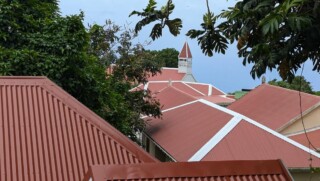Wageningen University: Part of Sand Artificial Beach Chogogo will definitely end up in Sea
KRALENDIJK- An study commissioned by Wageningen University into the quality and situation of the sand that Chogogo spread as an addition to the natural beach in front of the hotel, concludes that part of that sand will eventually end up in the sea.
Wageningen University also states that it cannot be ruled out that the sand that washes into the sea will eventually lead to the demise of more coral. The study furthermore shows that the so-called retaining wall that was built and about which The BES-reporter wrote earlier, does not, or not sufficiently, retain the sand.
“Along most walls of the man-made beach, the sand is close to the top of the wall and less than the required 8 inches from the top. The sand appears to be transported towards the sea due to the prevailing wind direction (i.e. offshore to the west). In addition, the wind is blown out to sea through a kind of funnel between the buildings of the Chogogo beach and Dive Resort. In several places, the sand has already spilled over the wall and is mixed with the natural beach sand, which is much coarser,” the scientists said.
In addition, the researchers conclude that increasing the retaining will not necessarily solve the problem. “Even if the retaining wall is raised, the sand will continue to collect on the downwind side of the beach, and will eventually spill over it. The sand will therefore probably have to be redistributed manually on a regular basis, to prevent it from ending up in the sea”. It is also recommended that periodic re-inspections will take place to determine the exact situation.
Quality
The researchers are less negative about the quality of the sand supplied and its possible implications for the marine environment, about which there has been a lot of speculation lately. “The organic content of samples from Chogogo beach is very different from the artificial sand. On average, the artificial sand contains hardly any organic material (average value is 0.3%, 95% confidence limits of 0.13-0.49), while the natural sand has 2.4% (1.9, 2.9) of contains organic matter.
The researchers then state that the organic matter of the artificial beach sand is so low that the chance of microbial pollution is quite low, and negative consequences for corals from bacterial
pollution for the beach is not expected
Rethink artificial beaches
Based on the study the experts from Wageningen University recommend that the construction of artificial beaches on Bonaire should be reconsidered altogether.












